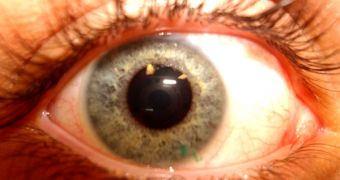As patients using eye drops on a regular basis can attest to, walking around all day with the bottle of medicine and putting drops of liquid in our eyes again and again is quite unpleasant. Thanks to an innovative type of contact lenses, created at the Harvard Medical School, people could soon have their drugs released straight from the lenses, gradually, which means that they will be able to stop carrying their regular drops everywhere they go. According to doctors, these medications are only marginally effective anyway.
Statistically, it's estimated that about one to seven percent of the drops patients put in their eyes actually have an effect on the conditions they are supposed to treat or improve. The rest of them flow at the back of the throat or down the cheeks, and are thus wasted, Wired reports. Therefore, finding a method that ensures a maximum absorption, and applying it to patients could significantly improve the effectiveness of the active substance in these drugs.
Because it's so uncomfortable to put eye drops in their eyes all the time, many people suffering from various conditions, including glaucoma, regularly fail to use their medication. Informatively, about 59 percent of glaucoma sufferers skip their drops, even though they are perfectly aware of the fact that not treating their condition could make them go blind. With precisely this in mind, researchers have finally managed, after more than a decade of effort, to create contacts that release medication and antibiotics steadily for more than 30 days in a row.
“The main way our lens differs is that it can provide large amounts of drug released at constant rates for long periods of time, which previous discoveries have not been able to do,” Daniel Kohane, who is a Harvard Medical School drug-delivery researcher, explains. He is also the co-author of a new, scientific paper detailing the achievement, published in the July issue of the journal Investigative Ophthalmology & Visual Science.
The lenses themselves are made from PLGA, a biodegradable polymer, and pHEMA, a hydrogel. Both materials are approved by the FDA for use by humans, so the science team is convinced that there will be no problem in them getting the go-ahead from the regulatory agency. Unlike previous attempts at creating similar lenses, the new model features a donut-shaped enclosure, which holds large concentrations of the active ingredient. The special shape prevents the user's view from being impaired in any way.

 14 DAY TRIAL //
14 DAY TRIAL //